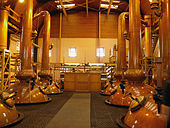Dalwhinnie distillery
 | |
| Region: Speyside | |
|---|---|
| Location | Dalwhinnie |
| Owner | Diageo |
| Founded | 1898 |
| Founder | John Grant, George Sellar and Alexander Mackenzie |
| Architect | Charles Chree Doig |
| Status | Active |
| Water source | Allt an t-Sluic |
| No. of stills |
|
| Capacity | 1,300,000 L |

Dalwhinnie distillery, situated in the Highland village of Dalwhinnie in Scotland, produces single malt Scotch whisky. Whilst labelled as Highland, as the Dalwhinnie distillery is located in the Badenoch and Strathspey ward of the Highland Council, it is in the Speyside region - noting that under SWA regulations the full Speyside region falls within the boundaries of the Highlands and so can be labelled as such.[2][3][4] The distillery is owned by Diageo.
The site for the distillery was chosen for its access to clear spring water from Lochan-Doire-Uaine and abundant peat from the surrounding bogs.[5]
Set in mountain scenery, Dalwhinnie is the highest distillery in Scotland with a visitors centre at 1,154 ft (352 m) above sea level. The highest distillery is actually
The name Dalwhinnie is derived from Gaelic word Dail Chuinnidh, which means meeting place, referring to the meeting of ancient cattle drovers' routes through the mountains.[7]
History
1897: John Grant of Grantown-on-Spey, George Sellar of Kingussie, and designer Alexander Mackenzie of Kingussie, put up an estimated £10,000 to build the Strathspey Distillery at Dalwhinnie between the Great North Road and the Highland Railway. Mackenzie had previous experience with designing a distillery in Kingussie. [8]
1898: In February production begins but by the summer the venture was already in liquidation. In October A. P. Blyth buys the distillery for his son and renames it Dalwhinnie announcing ‘considerable improvements on the building and plant’.[8]
1905: The largest distillers in the United States, Cook and Bernheimer, buy the distillery at auction for just £1,250. Many fear the take-over of the Scotch whisky industry. A huge warehouse in Leith blends Dalwhinnie with other whiskies "to suit the American palate".[9]
1919: Prohibition hits America. Dalwhinnie returns to Scottish hands; they are those of Sir James Calder, chairman of Macdonald Greenlees, also blenders in Leith.[10]
1926: Macdonald Greenlees is itself acquired; by the Distillers Company Ltd. (DCL). Dalwhinnie gains its fifth owner in under thirty years and is licensed to James Buchanan and Co. (famous for the Black and White and Buchanan blends).[8]
1934: A fire in the early hours of 1 February closes the distillery for four years; perhaps coincidentally this is also the year in which electricity first comes to the village, replacing paraffin lamps.[10]
1937: As rebuilding continues, winter snowdrifts 20 ft (6.1 m) high hamper work.[10]
1938: After four years Dalwhinnie re-opens in April, rebuilt and refreshed.[10]
1940: Dalwhinnie shuts again, in common with most distilleries, as a result of wartime restrictions on their use of barley.[10]
1961: The wash stills are converted to steam heating from a coal-fired boiler.[8]
1968: The maltings cease production. Barley is now brought in from specialist maltsters for greater control over peatiness and alcohol yield.[8]
1969: British Rail closes the distillery’s private siding; Dalwhinnie whiskies now leave for the south by road.[8]
1972: Oil-firing replaces coal as modernisation continues.[8]
1987: The distillery becomes part of United Distillers. United Distillers was a Scottish company formed in 1987 combining the businesses of Distillers Company and Arthur Bell & Sons, both owned by Guinness. During a modernisation of the Dalwhinnie plant the traditional worm tubs were removed and shell and tube condensers installed.[10]
1989: Dalwhinnie 15 year old becomes one of the Six Classic Malts of Scotland.[11]
1991: New visitor centre opens.[11]
1994: Dalwhinnie is confirmed by the Met. Office as having the coldest average recorded temperature, 6 °C (43 °F), of any inhabited region in Scotland and probably the U.K.[11]
1995: Distillery refitted. Traditional worm tubs are reinstated, having been removed several years earlier.[11]
1997: Diageo was formed in 1997 from the merger of Guinness and Grand Metropolitan and Dalwhinnie became part of the drinks giant’s portfolio.[12]
Variants
As of 2019, Dalwhinnie single malt whiskies are available in the following expressions:[13]
- Standard 15-year-old
- More mature 25-, 29- and 36-year-olds
- Distillers Edition
- Winter's Gold
See also
- Whisky
- Scotch whisky
- List of whisky brands
- List of distilleries in Scotland
Notes
- ^ Dalwhinnie distillery
- ^ "Dalwhinnie - Scottish Whisky". www.scotlandwhisky.com/distilleries/dalwhinnie. Retrieved 13 October 2023.
- ^ "Dalwhinnie - Scottish Whisky". scotchwhisky.com/whiskypedia/1837/dalwhinnie. Retrieved 13 October 2023.
- ^ "The Scotch Whisky Regulations 2009". www.legislation.gov.uk/uksi/2009/2890/regulation/10/made. Retrieved 13 October 2023.
- ^ "Dalwhinnie Distillery". ForWhiskeyLovers.com. Retrieved 8 October 2023.
- ^ "DALWHINNIE - Whisky Antique, Whisky & Spirits". www.whiskyantique.com. Retrieved 8 October 2023.
- ^ O'Donoghue, Deborah (24 June 2021). "Dalwhinnie Distillery – a marriage in the mountains". Travel Tomorrow. Retrieved 8 October 2023.
- ^ a b c d e f g Kindersley, Dorling (2008). Whisky. Dorling Kindersley Limited.
- ISBN 90-5764-236-0
- ^ ISBN 90-5764-236-0
- ^ a b c d "DALWHINNIE - Whisky Antique, Whisky & Spirits". www.whiskyantique.com. Retrieved 8 October 2023.
- ISSN 0362-4331. Retrieved 7 October 2023.
- ^ "Our brands: Dalwhinnie". Malts.com. Diageo. Retrieved 26 December 2019.
References
- Brander, Michael (1996). Brander's Guide to Scotch Whisky (5 ed.). New York: Globe Pequot. p. 70. OCLC 34851266.[permanent dead link]
- Smith, Robin (2001). Lawson, Alan (ed.). The Making of Scotland: A Comprehensive Guide to the Growth of its Cities, Towns, and Villages. Edinburgh: Canongate. pp. 240–241. OCLC 48920986.
External links
- Dalwhinnie Distillery (Diageo) – official company site

